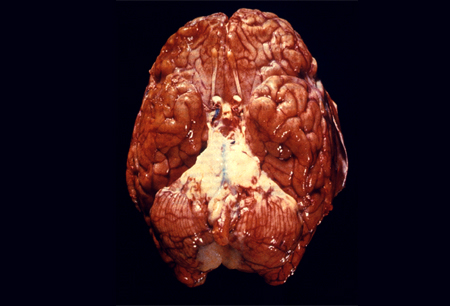The routine use of Haemophilus influenzae type b (Hib) and conjugate pneumococcal vaccines in the UK and other developed countries has markedly reduced the overall incidence of bacterial meningitis.[2]Brouwer MC, van de Beek D. Epidemiology of community-acquired bacterial meningitis. Curr Opin Infect Dis. 2018 Feb;31(1):78-84.
http://www.ncbi.nlm.nih.gov/pubmed/29176349?tool=bestpractice.com
[4]Hsu HE, Shutt KA, Moore MR, et al. Effect of pneumococcal conjugate vaccine on pneumococcal meningitis. N Engl J Med. 2009 Jan 15;360(3):244-56.
http://www.nejm.org/doi/full/10.1056/NEJMoa0800836#t=article
http://www.ncbi.nlm.nih.gov/pubmed/19144940?tool=bestpractice.com
[5]Castelblanco RL, Lee M, Hasbun R. Epidemiology of bacterial meningitis in the USA from 1997 to 2010: a population-based observational study. Lancet Infect Dis. 2014 Sep;14(9):813-9.
http://www.ncbi.nlm.nih.gov/pubmed/25104307?tool=bestpractice.com
[6]Schuchat A, Robinson K, Wenger JD, et al; Active Surveillance Team. Bacterial meningitis in the United States in 1995. N Engl J Med. 1997 Oct 2;337(14):970-6.
http://www.nejm.org/doi/full/10.1056/NEJM199710023371404#t=article
http://www.ncbi.nlm.nih.gov/pubmed/9395430?tool=bestpractice.com
[7]Centers for Disease Control and Prevention. Meningitis: resources for healthcare professionals. August 2019 [internet publication].
https://www.cdc.gov/meningitis/clinical-resources.html
However, because of limited economic resources and poor living conditions, many developing countries continue to have high rates of disease.
Streptococcus pneumoniae is the most common cause of bacterial meningitis in many countries worldwide.[4]Hsu HE, Shutt KA, Moore MR, et al. Effect of pneumococcal conjugate vaccine on pneumococcal meningitis. N Engl J Med. 2009 Jan 15;360(3):244-56.
http://www.nejm.org/doi/full/10.1056/NEJMoa0800836#t=article
http://www.ncbi.nlm.nih.gov/pubmed/19144940?tool=bestpractice.com
However, after the introduction of the 13-valent pneumococcal conjugate vaccine (PCV13), the incidence of invasive pneumococcal disease in England and Wales decreased by 32%.[8]Waight PA, Andrews NJ, Ladhani SN, et al. Effect of the 13-valent pneumococcal conjugate vaccine on invasive pneumococcal disease in England and Wales 4 years after its introduction: an observational cohort study. Lancet Infect Dis. 2015 May;15(5):535-43.
https://www.thelancet.com/journals/laninf/article/PIIS1473-3099(15)70044-7/fulltext
http://www.ncbi.nlm.nih.gov/pubmed/25801458?tool=bestpractice.com
S pneumoniae can cause systemic infection at any age.[3]Sáez-Llorens X, McCracken GH Jr. Bacterial meningitis in children. Lancet. 2003 Jun 21;361(9375):2139-48.
http://www.ncbi.nlm.nih.gov/pubmed/12826449?tool=bestpractice.com
Neisseria meningitidis serogroup B is the predominant cause of meningococcal meningitis in Europe, the US, and the Western Pacific. Meningococcal serogroups C and W are most common in most of Africa and Latin America. Serogroup Y cases mostly occur in Nordic countries.[9]Oordt-Speets AM, Bolijn R, van Hoorn RC, et al. Global etiology of bacterial meningitis: a systematic review and meta-analysis. PLoS One. 2018;13(6):e0198772.
https://www.ncbi.nlm.nih.gov/pmc/articles/PMC5995389
http://www.ncbi.nlm.nih.gov/pubmed/29889859?tool=bestpractice.com
Listeria monocytogenes is a common cause of bacterial meningitis in patients using immunosuppressive drugs, people who misuse alcohol, and patients with diabetes mellitus.[10]Koopmans MM, Brouwer MC, Bijlsma MW, et al. Listeria monocytogenes sequence type 6 and increased rate of unfavorable outcome in meningitis: epidemiologic cohort study. Clin Infect Dis. 2013 Jul;57(2):247-53.
https://academic.oup.com/cid/article/57/2/247/314829
http://www.ncbi.nlm.nih.gov/pubmed/23592828?tool=bestpractice.com
[11]van Veen KE, Brouwer MC, van der Ende A, et al. Bacterial meningitis in diabetes patients: a population-based prospective study. Sci Rep. 2016 Nov 15;6:36996.
https://www.ncbi.nlm.nih.gov/pmc/articles/PMC5109544
http://www.ncbi.nlm.nih.gov/pubmed/27845429?tool=bestpractice.com
Zoonotic causes of bacterial meningitis are rare, but important to consider when there is a history of exposure to animals. Streptococcus suis, most prevalent in Southeast Asia, is associated with raw pork meat and pig farming. Other zoonotic pathogens include Capnocytophaga canimorsus (associated with dogs), Campylobacter fetus (cattle), and Streptococcus equi (horses).[12]van Samkar A, Brouwer MC, Schultsz C, et al. Capnocytophaga canimorsus meningitis: three cases and a review of the literature. Zoonoses Public Health. 2016 Sep;63(6):442-8.
http://www.ncbi.nlm.nih.gov/pubmed/26693951?tool=bestpractice.com
[13]van Samkar A, Brouwer MC, van der Ende A, et al. Streptococcus equi meningitis. Clin Microbiol Infect. 2016 Jan;22(1):e3-4.
https://www.clinicalmicrobiologyandinfection.com/article/S1198-743X(15)00818-6/fulltext
http://www.ncbi.nlm.nih.gov/pubmed/26369601?tool=bestpractice.com
[14]van Samkar A, Brouwer MC, van der Ende A, et al. Campylobacter fetus meningitis in adults: report of 2 cases and review of the literature. Medicine (Baltimore). 2016 Feb;95(8):e2858.
https://www.ncbi.nlm.nih.gov/pmc/articles/PMC4779013
http://www.ncbi.nlm.nih.gov/pubmed/26937916?tool=bestpractice.com
For information on meningococcal disease caused by N meningitidis (not covered here) see Meningococcal disease.
